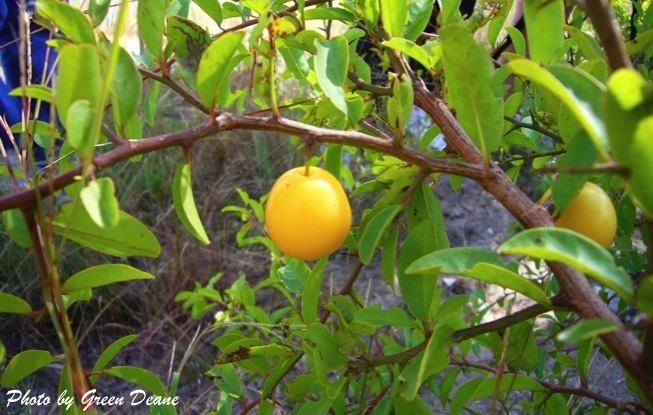
Tallow Plums turn bright yellow when ripe and are easy to identify. Photo by Green Deane
Last Sunday’s foraging class — Haulover Canal — was a hot one with a lot of walking. Thanks for hanging in there. It’s not easy this time of year. The mosquitoes weren’t bad but the ankle-scratching vines left their mark. Unlike a few weeks earlier the drawbridge was working and we got to cover all four compass points of the canal. On the southwest bank there were many unripe Tallow Plums. Give them a month. The Passionvines were fruiting as was an easy-to-access hickory. We also saw several of the salt tolerant species such as Sea Blite, Glasswort, Beach Carpet and some fruitless Goji Berries. Look for them starting around Christmas.
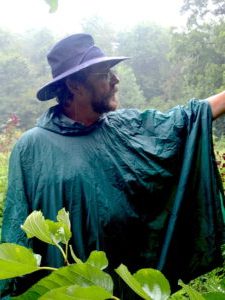
Classes are held rain or shine. Tropical storms and hurricanes are exceptions.
This foraging week’s classes are a bit of something old and something new (And while we are not dodging tropical storms this weekend next week’s classes might have to be adjusted. I study the weather a couple of weeks out when scheduling class locations.) This Saturday’s class is in Mead Garden, centrally located, full of edible species, easy walking. Sunday’s class is free though donations will be accepted. Why is Sunday’s class free? It’s a new location I’ve never been to. So it’s really a scouting trip for a class location north of Daytona but south of Jacksonville (who knows when that campus will be open regularly again.) Unlike already-chosen locations I don’t know what plants this site will produce.
Saturday, August 22nd, Mead Garden: 1500 S. Denning Dr., Winter Park, FL 32789. 9 a.m. to noon. The entrance is on the west side of Denning. Some GPS maps put it wrongly on the east side off Pennsylvania.
Sunday, August 23rd, Princess Place Preserve, 2500 Princess Place Road, Palm Coast, FL, 32137. 9 a.m. to noon? This class will be donations only. No charge. I have not been to this location but am visiting it to perhaps make it a permanent class location. As to where to meet … how about the parking lot? Discover the park and plants with me.
Saturday August 29th, Colby-Alderman Park: 1099 Massachusetts Street, Cassadaga. Fla. 32706. 9 a.m. to noon. Meet by the bathrooms.
Sunday August 30th, Eagle Park Lake, 1800 Keene Road, Largo, FL 33771. Meet at the pavilion near the dog park. 9 a.m. to noon.
For more information, to pre-pay, or to sign up of a class go here.
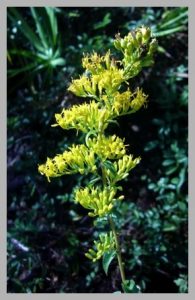
Some goldenrod tastes like anise. Photo by Green Deane
In blossom now and seen last week at Haulover is Goldenrod. It is a bit of a treasure hunt and disappointment. The treasure hunt is that one species is better than all the rest for tea, Solidago odora. It does grow here, has an anise flavor, but is hard to find. It’s reported in most counties but is not common. Goldenrod grows in about half of the United States, southwest to northeast. Other Goldenrod species can also be made into tea, perhaps all of them particularly for herbal applications, but they don’t taste anywhere near as good. In fact, after the “Boston Tea Party” of 1773 halted tea imports colonialists drank Goldenrod tea and even exported some to China. It did not catch on. However, every time I see a Goldenrod I pull off a leaf and crush it hoping to detect the tell-tale anise smell. It’s a golden treasure hunt.
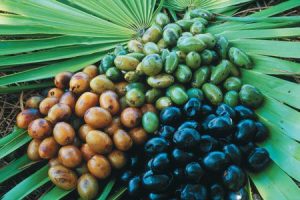
Saw Palmetto berries go from green to gold to black.
The “revolting” flavor of ripe Saw Palmetto berries will soon be upon us. I’m not sure they are an “acquired” taste or a tolerated one. You will either be able to eat them or not. Basically they tastes like vomit. To be a little more gracious they taste like an intense blue cheese with some burning hot pepper tossed in. Once you get used to them they are… endurable. But if you were hungry you would crave them in that they have all the amino acids humans need to be healthy. They are good for you even if you don’t like them and should be on the top of every vegetarians list of go-to plants. As with some fruit — Durian for example — the smell is enough to dissuade many people from eating them, hungry or not. Saw Palmetto berries will be ripening for the next few weeks. They start out green, turn to gold, then ripen to black. If you are adventurous you have been forewarned.
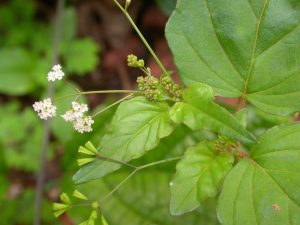
Boerhavia erecta, a Florida native.
As mentioned above foraging is like treasure hunting. While pedaling once in Apopka I had to stop at an intersection and noticed some Boerhavia diffusa. It’s a common barely edible probably from India or near there. One usually finds it in somewhat trashy ground such as sidewalk cracks, parking lots, and dumps. So when I stopped at the intersection it was no surprise to see Boerhavia growing there. But growing next to it was a white Boerhavia. That I had never seen. And the leaves were more pointed than the common species. A little bit of research suggests I found B. erecta, which surprisingly is a Florida native. It has spread to other parts of the world, however, and is reportedly edible and medicinal like B. difussa. After a bit more research I might have to update my article on the species. Until then you can read about the ruby-blossomed B. diffusa here.
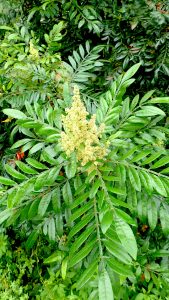
Sumacs are in blossom. Photo by Green Deane
What is that? It’s a common question locally now that sumacs are in bloom. Their creamy terminal blossoms stand out looking somewhat exotic among the dark green foliage. The most common species here is Winged Sumac which is also one of the most widely-distributed sumac in North America. It’s found nearly everywhere though in different locales other species may dominate. Where I grew up in Maine Staghorn Sumac was the common species and grew quite tall. I see them often when I visit North Carolina. The key to making sure you have an edible sumac and not toxic Poison Sumac or Brazilian Pepper is location of the blossom and subsequent fruit. Edible sumacs have terminal clusters of medium to dark red berries covered with fine hair. In this case “terminal” means they are on the very end of the branch, like the blossom on the left. Brazilian Pepper has pink berries that are further down the branch. Poison Sumac, which only grows only in wet places, has dull cream to green-cream berries also further down on the stem. To read more about sumacs go here.

Green Deane videos are now available on a USB.
Changing foraging videos: My nine-DVD set of 135 videos has been selling for seven years and are still available. They are the same videos I have on You Tube. Some people like to have a separate copy. A second option is a16-gig USB that has those 135 videos plus 15 more. While the videos can be run from the DVDs the videos on the USB have to be copied to your computer to play. They are MP4 files. The150-video USB is $99 and the 135-video DVD set is now $99. The DVDs will be sold until they run out then will be exclusively replaced by the USB. This is a change I’ve been trying to make for several years. So if you have been wanting the 135-video DVD set order it now as the price is reduced and the supply limited. Or you can order the USB. My headache is getting my WordPress Order page changed to reflect these changes. We’ve been working on it for over three weeks. However, if you want to order now either the USB or the DVD set make a $99 “donation” using the link at the bottom of this page or here. That order form provides me with your address, the amount — $99 — tells me it is not a donation and in the note say if you want the DVD set or the USB.

Green Deane Forum
Want to identify a plant? Perhaps you’re looking for a foraging reference? You might have a UFO, an Unidentified Flowering Object, you want identified. On the Green Deane Forum we — including Green Deane and others from around the world — chat about foraging all year. And it’s not just about warm-weather plants or just North American flora. Many nations share common weeds so there’s a lot to talk. There’s also more than weeds. The reference section has information for foraging around the world. There are also articles on food preservation, and forgotten skills from making bows to fermenting food.
This is weekly newsletter #419, If you want to subscribe to this free newsletter you can find the sign-up form in the menu at the top of the page.
To donate to the Green Deane Newsletter click here.

